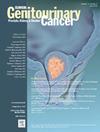Increased Severity of Prostate Cancer Presentation in an Appalachian Cohort Compared to National Data
IF 2.7
3区 医学
Q3 ONCOLOGY
引用次数: 0
Abstract
Background
Prostate cancer is the second leading cause of cancer death among American men, with known disparities by geography, socioeconomic status, and access to care. Data on prostate cancer presentation in Appalachia are scarce.
Methods
We retrospectively reviewed 160 first‐time transrectal ultrasound‐guided prostate biopsies from 2022 to 2024 at a single Appalachian institution and compared them to 8776 positive biopsies from the PLCO trial. Gleason scores were grouped as 1 (≤ 6), 2/3 (7), 4 (8), and 5 (≥ 9). We used chi‐square tests to compare grade distributions and PSA categories (< 4, 4-10, 10-20, > 20 ng/mL), Wilcoxon rank‐sum tests for age and median PSA by grade, and sequential logistic regression (unadjusted; +age; +PSA+age) to identify independent predictors of Appalachian cohort membership.
Results
Appalachian patients were more likely to present with Grade 4 (19.1% vs. 7.9%) and Grade 5 disease (10.1% vs. 5.0%; χ² = 49.2, P < .001) and had older median age (e.g., Grade 1: 66 vs. 63 years, P = .0033) and higher median PSA (e.g., Grade 1: 8.6 vs. 5.7 ng/mL, P = .0001). PSA category distribution also differed (χ² = 44.8, P < .001). In fully adjusted models, Grade 4 (OR 2.54, P = .002) and Grade 5 (OR 2.80, P = .002) remained independent predictors of Appalachian cohort membership, while PSA was not (P = .280).
Conclusions
Appalachian patients exhibit a disproportionately high prevalence of advanced‐grade prostate cancer that persists after accounting for age and PSA. Tailored, region-specific strategies are needed to enhance early detection and reduce persistent disparities in care.
与全国数据相比,阿巴拉契亚队列中前列腺癌出现的严重程度增加
背景:前列腺癌是美国男性癌症死亡的第二大原因,在地理、社会经济地位和获得治疗方面存在着已知的差异。关于前列腺癌在阿巴拉契亚地区表现的资料很少。方法回顾性回顾了一家阿巴拉契亚机构从2022年到2024年的160例首次经直肠超声引导的前列腺活检,并将其与来自PLCO试验的8776例阳性活检进行了比较。Gleason评分分为1分(≤6分)、2/3分(7分)、4分(8分)和5分(≥9分)。我们使用卡方检验来比较等级分布和PSA类别(<;4,4 - 10,10 -20, >;20 ng/mL),按年级进行年龄和中位数PSA的Wilcoxon秩和检验,并进行顺序逻辑回归(未经调整;+年龄;+PSA+年龄),以确定阿巴拉契亚队列成员的独立预测因素。结果appalachian患者更有可能出现4级(19.1%比7.9%)和5级(10.1%比5.0%;χ²= 49.2,P <;.001),中位年龄较大(例如,1级:66对63岁,P = 0.0033),中位PSA较高(例如,1级:8.6对5.7 ng/mL, P = 0.0001)。PSA类别分布差异有统计学意义(χ 2 = 44.8, P <;措施)。在完全调整的模型中,4级(OR 2.54, P = .002)和5级(OR 2.80, P = .002)仍然是Appalachian队列成员的独立预测因子,而PSA不是(P = .280)。结论:考虑到年龄和PSA因素,sappalachian患者表现出不成比例的高晚期前列腺癌患病率。需要制定有针对性的区域战略,以加强早期发现并减少护理方面的持续差异。
本文章由计算机程序翻译,如有差异,请以英文原文为准。
求助全文
约1分钟内获得全文
求助全文
来源期刊

Clinical genitourinary cancer
医学-泌尿学与肾脏学
CiteScore
5.20
自引率
6.20%
发文量
201
审稿时长
54 days
期刊介绍:
Clinical Genitourinary Cancer is a peer-reviewed journal that publishes original articles describing various aspects of clinical and translational research in genitourinary cancers. Clinical Genitourinary Cancer is devoted to articles on detection, diagnosis, prevention, and treatment of genitourinary cancers. The main emphasis is on recent scientific developments in all areas related to genitourinary malignancies. Specific areas of interest include clinical research and mechanistic approaches; drug sensitivity and resistance; gene and antisense therapy; pathology, markers, and prognostic indicators; chemoprevention strategies; multimodality therapy; and integration of various approaches.
 求助内容:
求助内容: 应助结果提醒方式:
应助结果提醒方式:


